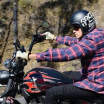After prototype models of the Hawkeye 400 were tested in Australia earlier this year, the first production run at the Polaris manufacturing plant in Roseau, Minnesota, finished in June.
The first shipment has now arrived in Australia, the only country in the world to sell the model. The big brother of the Hawkeye 300 2x4 arrives at $7895 which is between the Hawkeye 300 ($5995) and Sportsman 400 4X4 ($8695).
Polaris Industries Australia national marketing manager Neil Anderson says the full-size chassis 2x4 costs more than Asian-made machines, but is a "smooth-riding, American-Made, full-size ATV". Anderson says it will suit farmers who want all the towing, carrying and ride qualities of a full-size Polaris, but have flat country not requiring 4x4. He says there are limited production volumes this year and the product is backed by a Polaris-trained national dealer network with Polaris genuine parts backup and two-year warranty.
"Most dealers will not get stock until September and most are likely to be pre-sold," he says.
The Hawkeye 400 shares most features with the Sportsman 400 H.O, including the 455cc liquid-cooled engine and a radiator now mounted 7.6cm higher and angled rearward to keep it out of the mud. It features independent rear suspension with 24.1cm of travel and MacPherson strut front with 20.8cm of travel to minimise body roll and 28.6cm of ground clearance. There is a 81.kg capacity rear rack, 40.8kg front rack, inside storage compartments and it has 555.7kg hitch towing capacity.
Anderson says summer rain in Queensland and Victoria has boosted sales of all-terrain vehicles in the first six months by 29.1 per cent to 10,544.
"The farm sector is experiencing massive growth because of the rain, but the recreation sector is pretty flat since the GFC hit," he says.
In Australia, Polaris has overtaken Suzuki for third position in ATV sales with 1882 in the first half, up 31.4 per cent. Sales leader is Honda (2780, up 42.6 per cent) followed by Yamaha (2434, 21.3 per cent).
Anderson says customers can expect to see more electric-powered Polaris hitting the market in coming years. He says they are suited to wineries, dairies, organic farms, horse studs and other boutique agriculture properties, especially those with indoor facilities because they are quiet and don't emit any CO2.
Polaris has one electric model, the Ranger EV ($19,999 driveaway) with 22kW of power, a top speed of 40km/h and 80km of range.
"These vehicles are a good fit for an organic farm where the owners don't want to store fuel on the property," he says. "It fits in with the whole ethos of organic so there are no diesel fumes belching all over the livestock or plants."
He says the vehicles are also popular at cellar doors and other farms with tourist attractions and eateries.
"It's much more impressive for those operations to have something quietly taking stock from A to B without belching diesel fumes around." Anderson says the Ranger EV is also a hit at dairies and horse studs. "It doesn't scare the stock or put the cows off their milk," he says. "If you have a million-dollar thoroughbred horse the last thing you want to do is spook it. It also means you can have your staff zipping around an agistment property without waking up animals."
Animals aren't the only ones able to sleep in while electric vehicles run their errands.
Anderson says the Range EV is being used at mines.
"There is a catering company in WA that bought a couple so they could deliver food to the mine site without waking workers," he says. "If you are in the middle of nowhere you want something that - rain, hail or shine - it can get to where you want. At mines you have people working 24 hours a day so you always have people sleeping."
Polaris has loaned Ranger EVs to various agricultural operations to trial such as the Sirromet Winery in Brisbane and the Foster's Group of wineries.
"Foster's have trialled and bought some for the Yarra Valley in particular and some wineries in the Margaret River area," he says.
The American Polaris company started making snowmobiles in 1956. They now represent just 10 per cent of the company's $2 billion annual global turnover, with ATVs and side-by-side machines representing 67 per cent. In 1998, the company branched out into road motorcycles with the Victory brand which is just 5 per cent of sales and this year acquired Indian motorcycles and GEM electric vehicles.
For more information, visit www.polarisindustries.com.au.






















.jpg)

